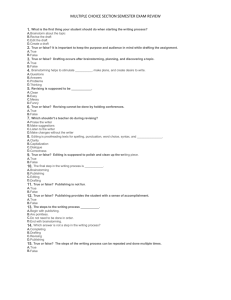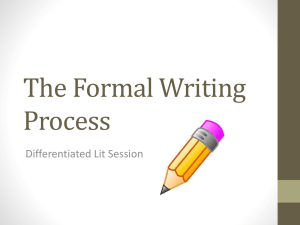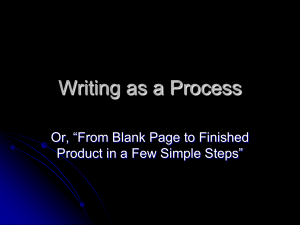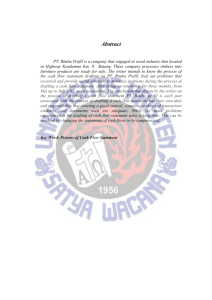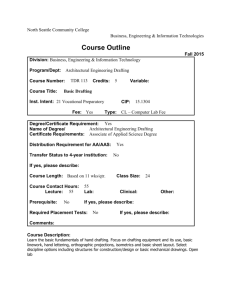Chalkboard Template
advertisement
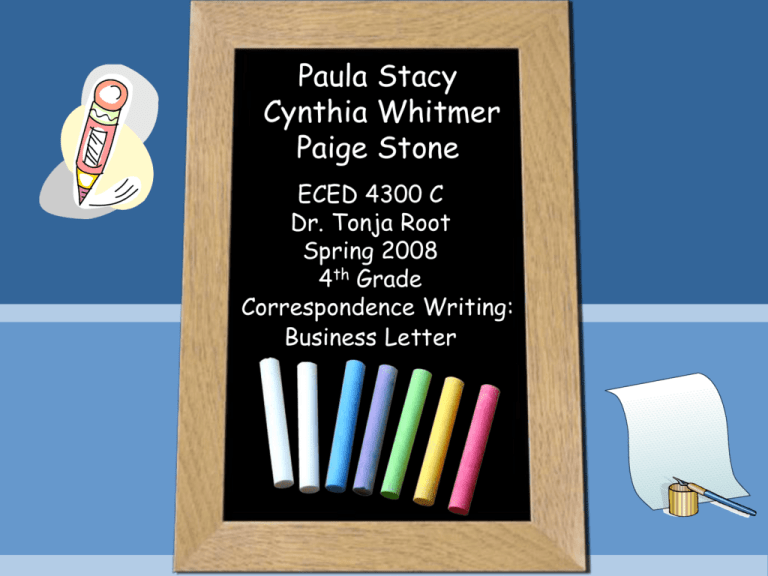
Paula Stacy Cynthia Whitmer Paige Stone ECED 4300 C Dr. Tonja Root Spring 2008 4th Grade Correspondence Writing: Business Letter GPS • ELA4W2 The student demonstrates competence in a variety of genres. • Critical Component: The student produces informational writing (e.g., report, procedures, correspondence) that: a. Engages the reader by establishing a context, creating a speaker’s voice, and otherwise developing reader interest. b. Frames a central question about an issue or situation. c. Creates an organizing structure appropriate to a specific purpose, audience, and context. d. Includes appropriate facts and details. e. Excludes extraneous details and inappropriate information. f. Uses a range of appropriate strategies, such as providing facts and details, describing or analyzing the subject, and narrating a relevant anecdote. g. Draws from more than one source of information such as speakers, books, newspapers, and online materials. h. Provides a sense of closure to the writing. PLO • Students will use the writing process to complete a graphic organizer during the prewriting stage in order to draft a business letter in which he/she will revise and edit. A Business Letter is Used… A Business Letter is used… • • • • • To make a suggestion Give an opinion Make a complaint Request permission or information Order a product A Business Letter is… • A formal means of communicating • Organized very specifically, must follow the format • Formal English should be used, no slang • Should be neat, No errors • Usually, all parts are left aligned Paula Stacy ECED 4300 C Dr. Tonja Root Spring 2008 4th Grade Correspondence Writing: Business Letter Prewriting Stage GPS • ELA4W2 The student demonstrates competence in a variety of genres. • Critical Component: The student produces informational writing (e.g., report, procedures, correspondence) that: b. Frames a central question about an issue or situation. c. Creates an organizing structure appropriate to a specific purpose, audience, and context. Pre-Writing PLO Drafting PLO • Students will complete a graphic organizer for a business letter during the prewriting stage of the writing process. Pre-Writing Business Letter • Write a business letter – To make a suggestion – Give an opinion – Make a complaint – Request permission or information – Order a product Pre-Writing Stage Pre-Writing • • First stage of the writing process Choices to make/things to consider – – – – – – Why write a business letter? What is their address? Who is the letter to? How will I greet the person? What will the letter say? How will the letter be closed? Remember! – Do not worry about spelling and punctuation – Jot down ideas – Sentence fragments are ok Pre-WritingPre-Writing Graphic Organizer Drafting Example Published Example Pre-Writing Citations Pre-Writing Citations • Time for Kids (2004). Time for kids homework helper. Retrieved April 11, 2008, from Time for kids web site: http://www.timeforkids.com/TFK/media/ hh/pdfs/ideaorganizers/business_letter_ ideaorg.pdf • Time for kids (2004). Time for kids homework helper. Retrieved April 11, 2008, from Time for Kids web site: http://www.timeforkids.com/TFK/media/hh/pdfs/samplepapers/b usinessletter_sample.pdf Cynthia Whitmer ECED 4300 C Dr. Tonja Root Spring 2008 4th Grade Correspondence Writing: Business Letter Drafting Stage GPS • ELA4W2 The student demonstrates competence in a variety of genres. • Critical Component: The student produces informational writing (e.g., report, procedures, correspondence) that: a. Engages the reader by establishing a context, creating a speaker’s voice, and otherwise developing reader interest. b. Frames a central question about an issue or situation. d. Includes appropriate facts and details. f. Uses a range of appropriate strategies, such as providing facts and details, describing or analyzing the subject, and narrating a relevant anecdote. g. Draws from more than one source of information such as speakers, books, newspapers, and online materials. h. Provides a sense of closure to the writing. Drafting PLO Drafting PLO • Students will use the completed graphic organizer during the drafting stage to draft a business letter. Drafting Stage Drafting Stage • Second stage of the writing process • Use information form the graphic organizer to write the business letter • Remember not spend time paying close attention to spelling and punctuation • This is a rough draft Drafting: Parts of a Business Letter • Return Address: the writer’s address (also called a header) • Date: month, day , & year • Inside address: – Who the letter is to: their name, title, and company – Address of person receiving the letter • Greeting, Salutation (should be professional) Drafting Continued Drafting: Parts Continued • Body of the letter (the purpose and details) – Tell who you are and why you are writing – Give a fact, detail, or example that supports your request – Give reason to act upon your request or concern – Thank the person for their considerations, reading your letter • Closing: (Regards, Sincerely, Yours Truly, From, Thank You) • Your signature • Your printed name Writing is Fun! Drafting Example Example Drafting Drafting Citations Drafting Citation • ReadWriteThink (2003). Students Materials: Letter Generator. Retrieved April 10, 2008, from ReadWriteThink website: http://readwritethink.org/materials/letter _generator/ • Money Instructor (2005). Writing a Business Letter. Retrieved April 10, 2008, from Money Instructor website: http://www.moneyinstructor.com/docs/pdf/busletexample.pdf Paige Stone ECED 4300 C Dr. Tonja Root Spring 2008 4th Grade Correspondence Writing: Business Letter Revising/Editing GPS • ELA4W2 The student demonstrates competence in a variety of genres. • Critical Component: The student produces informational writing (e.g., report, procedures, correspondence) that: e. Excludes extraneous details and inappropriate information. PLO PLO • Students will use the completed draft to revise and edit the business letter. Revising/Editing Stage • “Fine-tuning” • Even when a piece of writing sounds good, it can be revised and edited to be more effective and sound even better! • Once the rough draft is complete, re-read and review the piece of writing to improve it. Revising/Editing Stage • • • • Look for mistakes. Check spelling and punctuation. Be sure correct grammar is used. Change wording or sentence structure to eliminate confusing statements or to more effectively state. Revising/Editing a Business Letter • Be sure all components of the Business Letter are included– Return and inside addresses – Date – Greeting/salutation – Body and closing – Signature and printed name Revising/Editing a Business Letter Continued • Also, be sure the letter is written appropriately for the person it was written for. • Give more details if needed. Revising/Editing Example Revising/Editing Example Revising/Editing Citation • Letter Writing Guide (2006). Sample Business Letter. Retrieved April 12, 2008, from Letter Writing Guide website: http://www.letterwritingguide.com/ samplebusiness.htm
